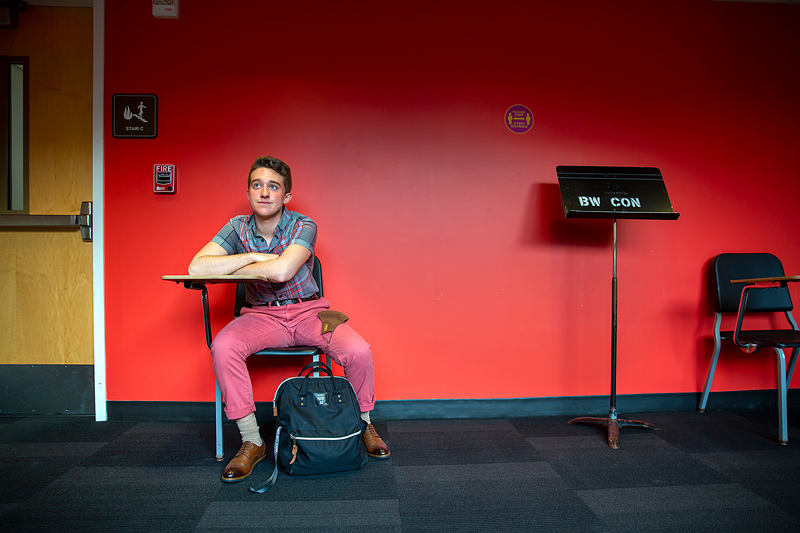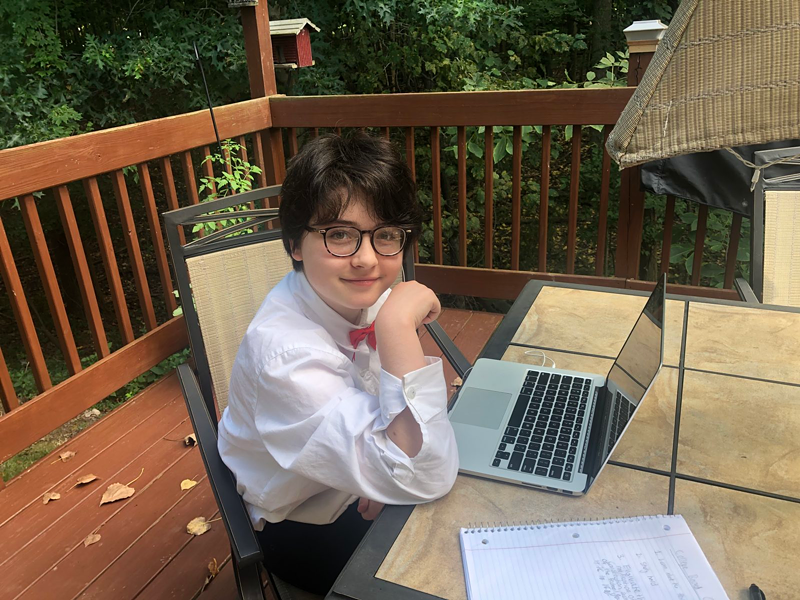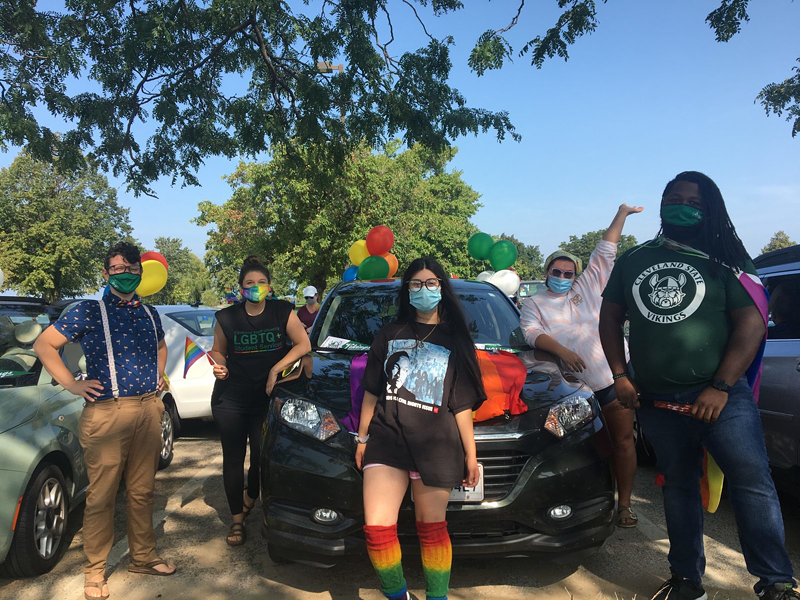When Tyler, a sophomore at Cleveland State University, started hormone replacement therapy two months before spring break, the last thing he expected was to spend the rest of the semester with his parents in Westbrook, New York. Tyler had been living with three other trans students he befriended through CSU’s LGBTQ+ Student Services before campus housing closed in mid-March. When Tyler moved in with his parents, they were still uncomfortable with his trans identity and were not using his preferred pronouns (he/his).
“I wasn’t out in high school and college was the first place I felt like I was actually able to be myself,” Tyler said. “I felt like my sense of community was ripped away all at once.”
Those first few months of quarantine, when Tyler didn’t have a laptop and couldn’t access CSU’s online counseling or the LGBTQ+ center’s virtual drop-ins, were emotionally rough. “The conversations I had with my parents were conversations I was not prepared for, especially being on hormones. For a while, it was like I was regressing back to my high school self at home.”
Since the start of the coronavirus pandemic, youth and young adults have experienced unprecedented levels of anxiety and depression due to social distancing and stay-at-home orders. LGBTQ+ youth are already at a higher risk than their non-LGBTQ+ peers for depression, anxiety, substance use, and suicidality. As students continue to be stuck at home for long periods of time, LGBTQ+ youth and young adults are especially vulnerable to being trapped in unsupportive environments with limited access to support networks.
The Trevor Project, the world’s largest crisis intervention organization for LGBTQ youth, released a research report this summer showing that COVID-19 social distancing, limited access to mental health services, and being trapped in an unsupportive environment has had serious implications on the mental health of LGBTQ+ youth. The report revealed that in 2020, 68% of LGBTQ+ youth reported symptoms of anxiety disorder, and 40% had seriously considered suicide.
Ohio LGBTQ+ advocates and organizations are experiencing similarly heightened levels of anxiety, depression, and suicidal ideation from LGTBQ+ young adults and students. They say a wider scope of approaches is needed to support youth during the pandemic, including creating more safe spaces, fostering connections between LGBTQ youth, and LGBTQ+ allies making themselves more available for support.
While youth have expressed suicidal thoughts in the past, Ohio organizations including Colors+ in Lorain county, LGBTQ+Allies in Lake County, and the LGBT Community Center in Cleveland all said they’ve received a higher volume of calls since the start of the pandemic. More parents are reaching out for help, as well.
Kristen Pepera, the director of Colors+, which provides services to youth under the age of 19, explained that in addition to COVID-related anxiety, youth have had more time in isolated environments to think and process previous traumas that are resurfacing during this stressful time.
“Calls have increased to our center during the pandemic, a majority of which are concerns from youth all over Ohio experiencing anxiety and depression — this is the new norm for the moment,” she said. “Since the pandemic began, we have had to call parents three times and emergency personnel twice in response to LGBTQ youth who said that they had a plan to take their life and were going to follow through in the next 24 hours.”
Ohio organizations say that more parents are reaching out, as well. “Since March, we’ve received more than 20 calls from parents and guardians looking for support for their LGBTQ youth that have just come out, compared to just a handful of those before the pandemic,” Pepera said.
A wider range of virtual safe spaces
LGBTQ+ organizations are creating a wider range of safe spaces to help youth cope and thrive during the pandemic. Kathy reached out to Colors+ this fall on behalf of her transgender, gender nonbinary and asexual fourteen year-old, Lane (they/their), to learn about virtual programs after Lane switched from a public school to online learning in the middle of the pandemic. Through Colors+, Lane was able to chat with other LGBTQ+ youth on Zoom, which is how they found out about and attended a virtual trans-camp with other teens with whom they still text back and forth.
“Colors+ was where I felt actually accepted for the first time and it allowed me to explore myself and be myself more,” Lane said. They said they feel more comfortable in the virtual classroom, and Lane doesn’t have to worry about students commenting on their appearance - something they regularly dealt with at public school.
“In online classes, I can introduce myself with my pronouns and most of the time other students don’t have any problem with it. It is a lot easier to come out when you don’t have to do it in person,” Lane said.
LGBTQ+ organizations and schools in Northeast Ohio are also increasing their virtual programming through Zoom support meetings, drop-in hours, games, and other events that took place in person before the pandemic. For example, The LGBTQ Community Center of Greater Cleveland now allows youth to text, email and message them through social media. The center is also partnering with Nomi, a virtual chat platform that connects people to mental health services.
More visibility of LGBTQ+ allies
In many places in Ohio, it’s still not safe to be out. Kathy and her husband have lived in a rural part of Lorain County for 16 years — one of the counties that have yet to pass or push for any kind of LGBT anti-discrimination ordinance, unlike the 26 other counties in Ohio that have passed ordinances in the absence of statewide protections for LGBT people. She said she feels uneasy about Lane’s safety at times.
“When we take walks in the neighborhood, we walk together,” Kathy said, glancing at Lane.
“Other than my parents and my friends online, I don’t feel supported in the area I live in,” Lane said. They recalled several boys in the neighborhood walking by and making fun of a “love is love” pride slate that Kathy had painted and put on the front porch.
Betty Jacobs, the Executive Director of LGBTQ+Allies Lake County, said her organization is dealing with this by making its constituency more visible in both online and in-person communities.. One of the major problems she faces in Lake County is the fear of coming out. “Lake County is a very conservative county, so most of the LGBTQ individuals I know are closeted still,” she said.
“Now that we are in a Zoom world, introduce yourself with your pronouns on a call or in an email, and get a coffee cup and put a little 4-inch pride flag in it and put it on your desk in plain sight,” she added. “You never know who will need that support.”
Lane said signs of support make them feel safe and welcome. “I would feel really good about walking in my neighborhood and seeing somebody else having a pride flag hanging up. It would make me feel not alone in my neighborhood and that people are accepting of me.”
Using discretion in online spaces
In today’s socially-distanced world, creating online spaces where LGBTQ youth can safely interact is more important than ever. Dan Eggers (he/they), a trans and gay freshman at Baldin Wallace University and one of this year’s recipients of the PFLAG scholarship, said it has been challenging for him to make connections with other students, especially while living in a single dorm his first year of college. He’s also the only trans student in his Music Theater major.
“I have yet to find a major sense of community here,” he said. “Most of the friends I’ve found at school since the pandemic started are from chatting during a Zoom class — when I see that someone has beta pronouns, I’ll message them and be like ‘Hey!!’”
Eggers lived with his mom in Birmingham, Alabama last semester during most of quarantine, where he was a vocal advocate about issues impacting the LGBTQ community in Alabama. Before that, he had participated in several panels that educated teachers on how they could make classrooms more inclusive for students in grades 5-12. He says the support he got while living with his mom during the pandemic helped him have a voice.
“This summer, I didn’t constantly have to worry if I would be safe at home, or are they going to misgender me today. Because that wasn’t a factor, I was able to do what I needed to do and expand the impact that I was having.”
Eggers was concerned about other LGBTQ students he hasn’t been able to connect with since the pandemic, because “sadly, they are living with parents that may be looking at their phones.”
One strategy that teachers and allies can use to connect with students in unsafe environments, Eggers suggested, is to use the chat feature on Zoom, because the contents delete when the Zoom meeting ends. He also said allies need to consider how they reach out to youth.
“Reach out to your queer friends and don’t just say ‘Hey, are you okay?’ or ‘Are your parents okay?’ because they might be monitored. Instead, ask if they want to have a Netflix Zoom party or engage them in an activity of some kind so they have something to look forward to.”
Tyler, the trans student at CSU, went a step further and said allies should ask permission from their gender nonbinary and trans youth friends before reaching out to them. “Talk to the person first and ask if you can use their preferred name or address the correspondence to a person the parents know, so that you are not accidentally outing anybody. Keep their environment secure for them for right now - at least while this lasts.”
Proactively connecting youth who need services most
Youth in low income households and/or hostile environments are the ones who need the most help during the pandemic. Brian Lutz, the QYou Program Coordinator at the LGBT Community Center of Greater Cleveland, said the most notable observation he’s seen is the demographic change in who’s participating in their virtual programming spaces.
“While more youth have participated in the center’s virtual programming spaces, they tend to be white students from more affluent areas of Cuyahoga County or they live outside of the area altogether, whereas youth of color who were regularly coming in to the center before COVID-19 have either dropped off completely or inconsistently attend virtual events,” he said.
Lauren Welch, Marketing and Communications Director of The LGBT Center in Cleveland, said that some youth might not feel comfortable asking for help or don’t have the means to do so if they do not have access to a computer, if they lack the privacy at home to speak up, or if they are in a household were other basic needs are not being met.
“If you are in an environment where you are not safe or you don’t feel comfortable being out, where do you take this call?” Welch said. “Sometimes we have some youth take calls at their friend’s house or they might call from their cell phones while they are taking a walk outside.”
The Trevor Project emphasized that efforts need to be made to find ways to ensure that LGBTQ youth know that they are not alone and feel encouraged to seek support and social connections through “means that do not rely on physical proximity.”
“Teachers, guidance counselors and staff now have more access to students and can pass helpful information about resources on to youth in a way that is safer than placing that pressure on students,” said Pepera of Colors+. She added that schools can “tuck in” information about LGBTQ+ hotlines next to other mental health hotlines for kids to carry home with them, instead of information that is specifically centered around LGBTQ issues.
Colleges can help by reaching out to students who may be dealing with isolation and lack of social connections during the pandemic. When campuses closed in March, CSU’s LGBTQ+ Student Services looked at the list of students who had signed into the center over the course of the last year. Staff then sent emails out to each one of those students to check in on how they were doing. Tyler, the trans student at CSU, remembers receiving one of those emails from CSU’s LGBTQ+ Student Services.
“All colleges need to be reaching out to their students, have a specific helpline for LGBTQ+ students through counseling centers, or have more virtual support groups,” Tyler said.
Kara Tellaisha, CSU’s LGBTQ+ Student Services Coordinator, said the center is also in the process of launching an LGBTQ podcast hosted by students. “Our goal this semester is to create a more diverse path for students to communicate with us,” she said. CSU also provided laptops and hotspots to students without internet access and equipment, which is how Tyler was able to eventually connect to the support groups he was cut-off from at the beginning of the shut-down.
Jacobs said allies need to have a sense of urgency. “I get the emails, social media messages, phone calls from people in Lake County looking for help and it is worse now than ever and it is scary,” she said. “Figure out a way to let people know that you are LGBTQ welcoming. I don’t care what that looks like. It will be the only thing that will help that anxiety and that worry right now.”
This story is sponsored by the Northeast Ohio Solutions Journalism Collaborative, composed of 20-plus news outlets including Eye on Ohio, which covers the whole state.





